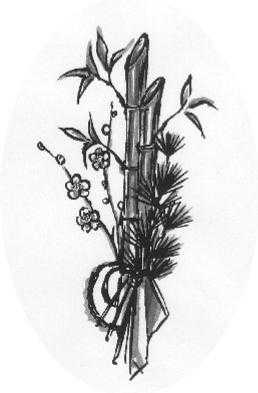松竹梅-序文 - Sho-chiku-bai - Introduction
These days, the Sho-chiku-bai are found in pictures in every way you can imagine. They are on kimono, foutons, carrying cloths, purses, and just about everything to be found in daily life. Just exactly what are they and where did they come from? The pine (sho)-bamboo (chiku)-apricot (bai) combination is called “Sho-chiku-bai” and symbolizes happiness in Japan.
今日、松竹梅は着物、布団、ふろしき、財布などに描かれて、私たちの日常生活の至るところで見ることができます。松竹梅とは何で、そしてどこから来たのでしょうか。松竹梅とは、読んで字のごとく、松、竹、梅を指し、日本では縁起の良いものとされています。
However, it actually originated in China for quite a different reason. In China, literary people were in the habit of gathering together in the winter and a picture of those three plants was always displayed and called, “The Three Friends of Winter.” It seems that it reminded them of summer and spring, making winter happier and easier to bear. Nowadays, according to my research, they are still a great part of daily life, as every festival, celebration, wedding and home has them on view somewhere.
松竹梅の起源は中国にありますが、元の意味は日本とは随分異なるようです。昔の中国の文人たちは、冬になると集会を開くのが常でした。その際、必ず松竹梅が描かれた絵が飾られ「歳寒三友」と呼ばれました。彼らはそれを見ながら春や夏を思い出し、冬の寒さを耐え忍んだのでしょう。中国人は、冬をより過ごしやすくするため松竹梅を活用したのです。 中国では今でも、祭りや祝い事、結婚式などでは松竹梅が登場し、また家のどこかで目にすることができます。
First, there was the pine tree as the symbol of happiness and prosperity. Then, the crane and tortoise were added, meaning “long life.” This happened around the ninth and tenth centuries. For many years, this group symbolized happiness and long life. In the Ashikaga Period (Muromachi), the bamboo was added and at the end of the 17th century, the Japanese apricot (ume) joined them. This made a group of five and we can still see this grouping.
松竹梅の歴史をひもといてみると、まず松が幸福と繁栄を表すものとして登場しました。 次に、長生きするようにとの願いを込めて鶴と亀が加えられました。9世紀から10世紀頃にかけてのことです。 松、鶴と亀は長い間人々にとって幸福と長寿の象徴でした。室町時代になるとこれに竹が加わり、最後に梅が17世紀の後半に加わって、松竹梅と鶴亀は縁起のよいものの代表となりました。現在でもこの組み合わせを目にすることができます。
Finally, the crane and tortoise were separated from the group and the sho-chiku-bai became the symbol for ‘happiness’ and the crane andtortoise the sign of ‘long life.’ I like to collect antiques and it is with these ideas that many antiques can be given dates. The Sho-chiku-bai was so popular that it was on almost everything and each appearance tells me about the time they were made.
後に、この中から鶴と亀が枝分かれし、最終的に松竹梅は幸福を、鶴亀は長寿をそれぞれ象徴するようになったのです。 私は骨董品を収集するのが好きですが、骨董品から当時のようすを知ることができるのが、その理由です。人々に常に愛されてきた松竹梅には特にそのことが当てはまり、それぞれの外観から作られた時代のようすがわかります。
The customs of Japan, as always, show the source of the culture and if we look at such an old Japanese art as tea, we can see the roots of Chinese culture popping up here and there. It is so fascinating to me to be able to do this, and understand what I am seeing! This is the joy I get out of my studies and research on Japan and the origins of culture and customs. Wouldn’t it make you feel proud to be able to tell other people and strangers about the culture of your own country? Study it and learn!
日本の慣習を調べていくと、文化の起源にたどり着きます。そして、茶道を始め日本の伝統的な芸術の多くに中国の影響を垣間見ることができます。このような発見、さらにその中から知識を得ることは、私にとってこの上ない喜びです。これこそ、日本および文化と慣習の起源について学ぶことのだいご味に他なりません。 自分の国の文化について、外国人に説明できることを誇らしいとは思いませんか。日本の歴史を探訪してみましょう。
